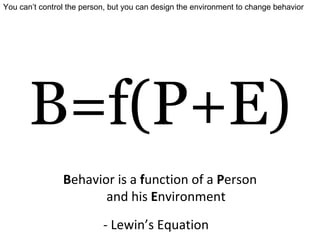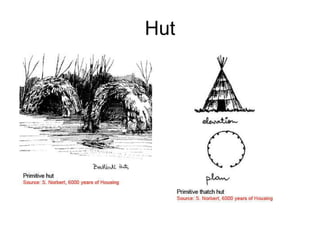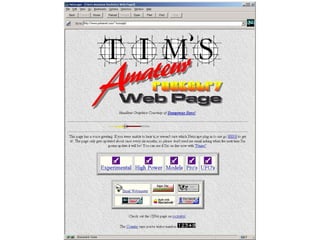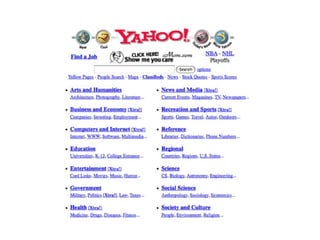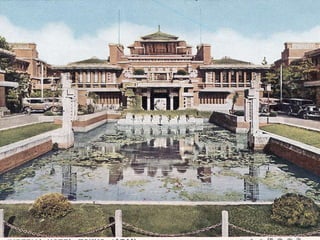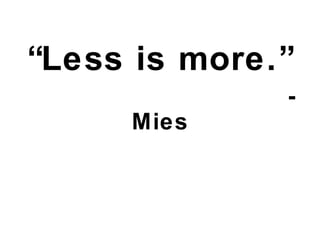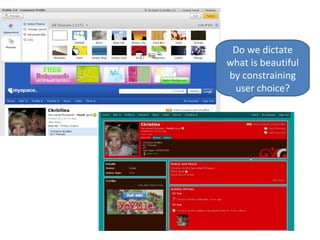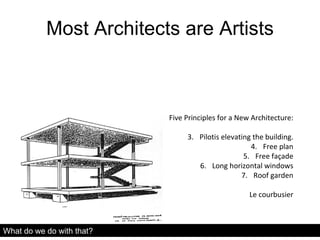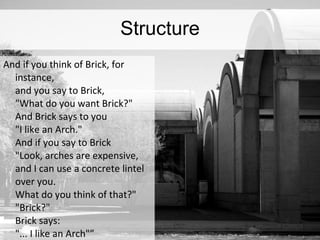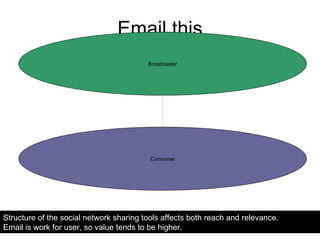Social Spaces: Lessons from Radical Architects
- 1. SOCIAL SPACES ONLINE AND OFF Lessons from Radical Architects
- 2. B=f(P+E) - Lewin’s Equation B ehavior is a f unction of a P erson and his E nvironment You can’t control the person, but you can design the environment to change behavior
- 3. The New Third Place? “ All great societies provide informal meeting places, like the Forum in ancient Rome or a contemporary English pub. But since World War II, America has ceased doing so. The neighborhood tavern hasn't followed the middle class out to the suburbs...” -- Ray Oldenburg
- 4. A SHORT HISTORY OF ARCHITECTURE
- 5. Cave
- 7. Hut
- 11. VITRUVIUS firmitas , utilitas , venustas : : durability, convenience, beauty
- 12. Durability “ Durability will be assured when foundations are carried down to the solid ground and materials wisely and liberally selected” Vitruvius
- 13. Frank Lloyd Wright’s Imperial Hotel, Japan, survived an earthquake The reflecting pool provided a source of water for fire-fighting; Cantilevered floors and balconies provided extra support for the floors; A copper roof, cannot fall on people below the way a tile roof can; Seismic separation joints, located about every 20 m along the building; Tapered walls, thicker on lower floors, increasing their strength; Suspended piping and wiring, instead of being encased in concrete, smooth curves, making them more resistant to fracture.
- 14. Technical Earthquakes Slow loading javascript fails on low bandwidth, and can cause users to accidently search for the label inside your search box. Is your site designed to be robust when things break (for example, filter out the label from the query. Or don’t place labels in fields; it reduces usage anyhow.) I’m searching for “my architect, not “movies, directors, actors”
- 15. Social Earthquakes If people post jobs in discussion areas, any user can move them to job board If people use connection invites to spam/market, they can be reported.
- 16. Prepare for Technical Tremors Execution Maintenance Scale Bandwidth Social Faultlines Innocents/Idiots Trolls Spammers Criminals
- 17. Convenience “ When the arrangement of the apartments is faultless and presents no hindrance to use , and when each class of building is assigned to its suitable and appropriate exposure” Vitruvius Sound familiar? We’re talking usability!
- 18. “ Early in life I had to choose between honest arrogance and hypocritical humility. I chose honest arrogance and have seen no occasion to change.” Frank Lloyd Wright Usonian houses were beautiful, human scaled.. And didn’t have closet space. Should we choose beauty over usability sometimes?
- 19. Human Human The Facebook Inbox is chock full of annoying non-human mails, despite the fact they know who is human and who I am connected to. Not convenient.
- 20. Bilbao did not leak. I was so proud.
- 21. I call it the "Then What?" Okay, you solved all the problems, you did all the stuff, you made nice, you loved your clients, you loved the materials, you loved the city, you're a good guy, you're a good person... and then what? What do you bring to it? See his great TED talk http://www.ted.com/talks/frank_gehry_asks_then_what.html
- 22. Beauty (delight) “ when the appearance of the work is pleasing and in good taste, and when its members are in due proportion according to correct principles of symmetry.” Vitrvius
- 23. “ Less is more.” ~ Mies
- 24. SEAGRAM BUILDING (Philip Johnson did interiors, 1957) This logical and elegant 38-story skyscraper (525' H) has alternating horizontal bands of bronze plating and bronze-tinted glass and decorative bronze I-beams which emphasize its verticality. Placed to the rear of its site and set back from Park Avenue, it incorporates a large plaza in the front as part of the design--thus avoiding the need for set-backs. It uses granite pillars at the base and has a two-story glass-enclosed lobby. Seagram Building New York City 1957 Is this Beautiful?
- 25. “ Less is a bore.” ~ Venturi
- 27. Do we dictate what is beautiful by constraining user choice?
- 28. Or support passionate use that may not meet our aesthetic standards?
- 29. Beautiful Convenient Durable Beautiful Convenient Durable
- 30. THE LESSON THAT WASN’T Not everyone is as user-centered as Christopher Alexander
- 31. 205 Structure Follows Social Spaces Conflict No building ever feels right to the people in it unless the physical spaces (defined by columns, walls, and ceilings) are congruent with the social spaces (defined by activities and human groups). Resolution A first principle of construction; on no account allow the engineering to dictate the building's form. Place the load bearing elements- the columns and the walls and floors- according to the social spaces of the building; never modify the social spaces to conform to the engineering structure of the building. Applies directly to Linkedin, Facebook, Mysapce, etc
- 32. 36. Degrees of publicness Conflict: People are different, and the way they want to place their houses in a neighborhood is one of the most basic kinds of difference. Resolution: Make a clear distinction between three kinds of homes―those on quiet backwaters, those on busy streets, and those that are more or less in-between. Make sure that those on quiet backwaters are on twisting paths, and that these houses are themselves physically secluded; make sure that the more public houses are on busy streets with many people passing by all day long and that the houses themselves are exposed to the passers-by. The in-between houses may then be located on the paths halfway between the other two. Give every neighborhood about an equal number of these three kinds of homes. Applies directly to Linkedin, Facebook, Mysapce, etc
- 33. Most Architects are Artists Five Principles for a New Architecture: Pilotis elevating the building. Free plan Free façade Long horizontal windows Roof garden Le courbusier What do we do with that?
- 34. LESSONS Radical architects and their
- 35. Space You don’t design space, you design objects that then shape the nature of the space
- 36. Identity Activity Relationships Social Space Sign-up Invitations Distribution (Viral)
- 37. Humans don’t like empty spaces. Create starter objects – newsfeeds can be good.
- 38. Site Site
- 39. Julia Morgan First Bay Tradition Natural material from site Traditional Craft Integrate in surrounds Each building a unique work of art
- 40. Site=Context Facebook- Personal LinkedIN - Professional
- 41. Structure And if you think of Brick, for instance, and you say to Brick, "What do you want Brick?" And Brick says to you "I like an Arch." And if you say to Brick "Look, arches are expensive, and I can use a concrete lintel over you. What do you think of that?" "Brick?" Brick says: "... I like an Arch"”
- 42. Email this Structure of the social network sharing tools affects both reach and relevance. Email is work for user, so value tends to be higher. Consumer Broadcaster
- 43. Newsfeed, Network Updates Sharing with your symetrical network has lower relevance but greater reach Consumer Consumer Consumer Consumer Consumer Broadcaster
- 44. Groups, Asymmetric Follow Sharing with your asymetrical network is broadcasting; less relevant still but great reach spark
- 45. Servant and Served Spaces ‘ I do not like ducts; I do not like pipes. I hate them really thoroughly, but because I hate them so thoroughly, I feel they have to be given their place . If I just hated them and took no care, I think they would invade the building and completely destroy it.’ The Notebooks and Drawings of Louis I. Kahn , 1962
- 46. Services (settings, in this case) are separated from served)
- 47. Services intergraded with served is easier to comprehend and use
- 48. Centre Pompidou was designed with services revealed rather than hidden
- 49. Revealing things usually only available to employees, such as statistics can provide interest and beauty inherit to the product.
- 50. Views Hey, it’s the Arc de Triomphe! Corbu’s surrealist apartment obscured views, rather than framed them to create interest
- 51. Views into people’s lives
- 52. Views into the service before you sign up
- 53. Proportion The Key Word is: Proportion. … Relative size, not over-all size, is the factor in determining guidelines which will satisfactorily influence attractive appearance.
- 54. Ad out of proportion to content
- 55. Ads reflect same sizes and shapes used in design
- 56. Speed 25mph 5 mph 60mph Medieval architecture designed to be walked by, prairie houses to drive by slowly at suburban speeds, and the strip for freeway speeds
- 57. Speed 25mph 5 mph 60mph Consider speed of use in design; do not slow interface with details upon sign up, richer interface for where people linger and socialize
- 58. Movement Gehry designed a static building to feel like it’s moving, inspired by dance
- 59. Why are our compositions so static? How should the eye move through this?
- 60. Games provide hints to new compositions, metaphors for information spaces
- 61. Gehry has been inspired recently by fish. What would a website be if it was a fish?
- 62. Twistori’s live stream of data reveals and intrigues. Do you need actual movement to engage?
- 63. “ Modern Systems! Yes indeed! To approach everything in a strictly methodical manner and not to waver a hair’s breath from preconceived patterns, until genius has been strangled to death and joie de vivre stifled by the system– that is the sign of our time.” Camillo Sitte
- 64. Page about Christina Ideas?
Editor's Notes
- Neolithic monument in present day Turkey Occupied between 6300 BC to 5400 BC Supported a population of up to 6000 people It was the largest and most cosmopolitan city of its time
- Commodity, firmness, delight
- The hotel had several design features that made up for its foundation: The reflecting pool (visible in the picture above) also provided a source of water for fire-fighting , saving the building from the post-earthquake firestorm; [1] Cantilevered floors and balconies provided extra support for the floors; A copper roof, which cannot fall on people below the way a tile roof can; Seismic separation joints , located about every 20 m along the building; Tapered walls, thicker on lower floors, increasing their strength; Suspended piping and wiring, instead of being encased in concrete, as well as smooth curves, making them more resistant to fracture. [2]
- The MIT project, they were interviewing me for MIT and they sent their facilities people to Bilbao. I met them in Bilbao. They came for three days. W: This is the computer building. G: They were there for three days and it rained every day. And they kept walking around. I noticed they were looking under things and looking for things, and they wanted to know where the buckets were hidden, people putting buckets out. I was clean. There wasn't a bloody leak in the place. It was just fantastic. But you've got to -- yeah, well, up until then, every building leaked. W: Frank had a sort of -- sort of had a fame -- his -- his fame was built on that in L.A. for a while. You know, Frank, you've all heard the Frank Lloyd Wright story when the guy -- the woman called and said, "Mr. Wright, my -- I'm sitting in the couch and the water's pouring in on my head," and he said, "Madame, move your chair." G: So, some years later I was doing a little house on the beach for Norton Simon, and his secretary was kind of a hell-on-wheels type lady -- called me and said, Mr. Simon's sitting at his desk, and the water's coming in on his head, and I told him the Frank Lloyd Wright story. W: Didn't get a laugh. G: No. Not now either.
- It's the "Then What?" that most clients who hire architects -- most clients aren't hiring architects for that. They're hiring them to get it done, get it on budget, you know, and not -- you know, be polite -- and they're missing out on the -- the real value of an architect.
- The Key Word is: Proportion. No matter what you may call it – beauty, eye appeal, good taste, or architectural compatibility, limiting the size of electrical advertising displays does not ensure any of these. Proper proportion – the relationship of the graphic elements to each other– are necessary to a good design, whether is be a matter of clothing, art, architecture or an electric sign. Relative size, not over-all size, is the factor in determining guidelines which will satisfactorily
- For next time: form factor and scanning; appropriateness of shape (tweet vs search)

